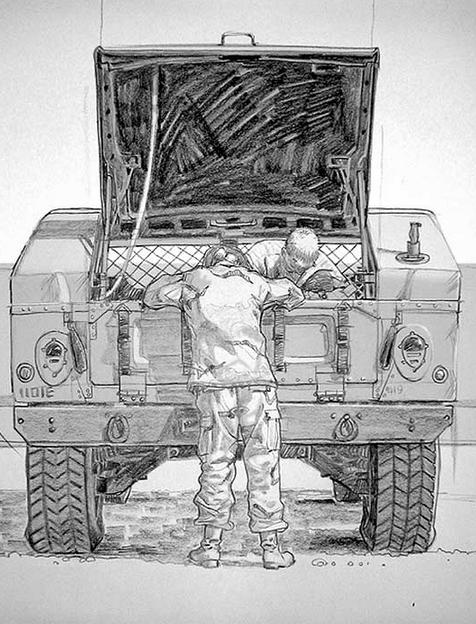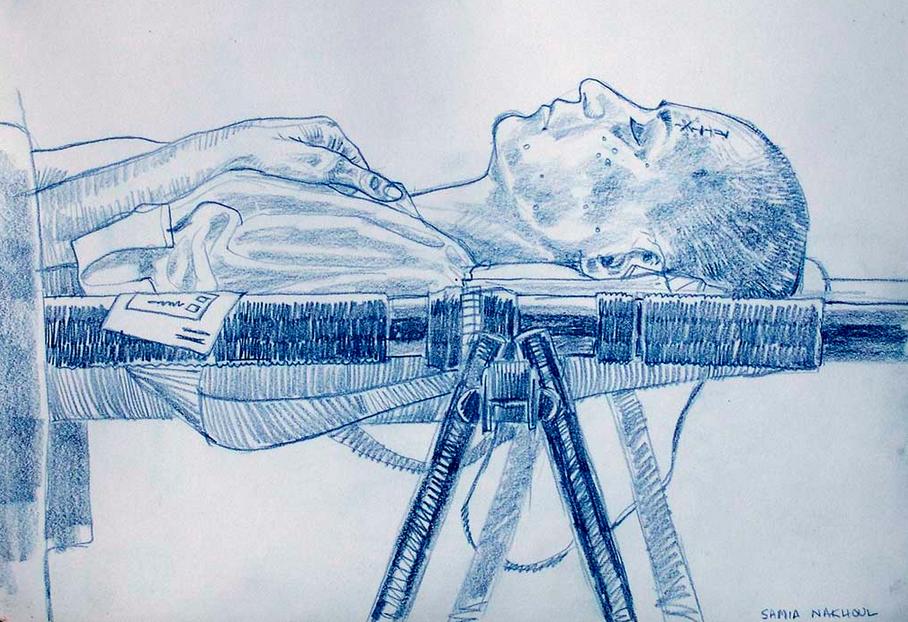PFC Justin Blue of the 3rd Platoon, Apache Troop, 1st Squadron, 75th Calvary Regiment, from the 2nd Brigade Combat Team, 101st Airborne Division (Air Assault). He is taking a break while on patrol near the village of Qalandrakhel a few miles outside of Bagram Airfield during an operation to suppress rockets that were being fired onto the base.
It's never easy to capture the images of a war, even if you're carrying the best camera money can buy. But what if your only tools to document conflict are a pencil and paper?

That’s the task that Richard Johnson takes on. The experienced graphic artist has traveled several times to Afghanistan and Iraq, where he hand-sketched images of the wars. His latest series for the Washington Post is titled "Drawing up the Drawdown."
Johnson returned to Maryland this week from his latest trip to Afghanistan, and he readily acknowledges the difficulties of his work.
“I have no clue what I’m doing,” he admits. “There is no doubt that when I’m out there — as well-intentioned as I may be — when we’re on patrol, my life is in the hands of those guys. And to a degree you can certainly understand why it takes me a while to gain [the soldiers’] trust, because I am a risk to them.”
He pushed himself to sketch nonstop during this latest trip. “Basically, I didn’t stop drawing for the six weeks I was there,” he says. That included sketching at times when he previously would have stopped.
“Places where I think I would’ve tucked my sketchpad out of the way — like flying with the doors open on a Blackhawk helicopter — I’ve kept my sketchpad in my hand and continued drawing through a lot of those scenarios,” he says.
That resulted in more candid images of the soldiers — and more honest encounters.
“For me, it’s all about these accidental interactions," he says. "If I can help it, it’s never staged. It’s always completely natural. Either I start drawing, and they ask me what the hell I’m doing, or I talk to them and ask them if I can draw them. Or, at times, I’ll just draw them anyways, and once they’re drawn, I’ll offer them up a sketch depending on what they’re doing.”
While he says his craft isn’t any better or worse than that of a photographer, he does admit that there are intrinsic differences between the two art forms — both in practice and effect.
“The image you’re seeing when you process something I’ve sketched is a much more human image than the camera ever gives you,” he explains. “For people looking at it, there’s a feeling of much more contact there.” He thinks that can be useful for many of the stories that seem to be overloading audiences this year.
.jpg&w=1920&q=75)
“It’s great for telling stories where you need people to care about people who are far, far away," he argue. "So your refugee camps in Syria; internally displaced camps inside Iraq; Ebola in Africa — these are stories I think that it could be used incredibly effectively."
And not lugging a camera around has an advantage any soldier would appreciate: It lets him skirt just the right side of the rules. “It kind of defies the military restriction on photography,” he explains. “There are places where the pencil has taken me that I don’t think they would allow cameras, at times.”
Johnson admits that documentary sketch art is a limited field — he says there’s only five or six people in the field altogether. Simply proving to publications that his work is valuable is a struggle in itself. But he stands by the idea that sketches can provide something that a photograph can’t.
“I have to work very hard to draw what I see, not what I feel about a person," he argue. "I think through doing that, I can provide a window for empathy for the viewer, where … they get pulled into something they wouldn’t necessarily read otherwise. It's a device for making people care.”

To see the rest of Richard Johnson's sketches from Afghanistan, visit his blog at The Washington Post website.
.jpg&w=1920&q=75)